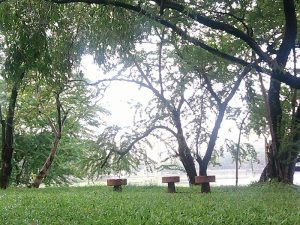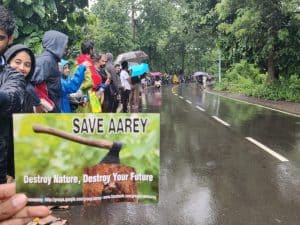Over 56% of the city’s transplanted trees in Mumbai failed to survive their shifting, revealed a Bombay High Court-appointed fact finding committee, entrusted to determine the status of such trees. The court-appointed committee inspected about 1483 fully grown trees transplanted since 2017, of which 824 trees were found to be either dead or on the verge of dying. The report presented in court found inadequate tree care and lack of scientific transplanting methods to be the root cause of the problem.
“The proportion of dead trees keeps on rising. In January 2018, 478 trees (42%) were found dead. The number rose to 759 trees (53%) in November 2018 and 824 trees (56%) in May 2019,” said tree activist and petitioner Zoru Bhathena.
Following objections raised by tree activists in tree-related petitions, the High Court chose to personally monitor the status of transplantations in the city and sought a report on the same. The HC insisted on the use of latest technology like machines, growth regulators, root stimulation hormones and even appointment of consultants to ensure better survival rates of transplanted trees. The HC also found that basic tree care procedures like maintenance schedules, fertigation, regular watering and removal of debris around trees were found wanting.

A committee has found that more than half of the trees transplanted in Mumbai have failed to survive. Pic: Anvitha/Wikimedia Commons (CC BY:SA 4.0)
Mumbai faces transplantation of about 5000 trees to compensate for the loss of tree cover due to various Metro projects across the city sparking citizen outrage on the subject. Transplanting a tree essentially means completely uprooting it from one place and planting it in another place. Though there is a proper scientific, botanical way of doing this, the entire process is shrouded in secrecy and camouflage in the city. The HC committee found that geo tagging of such transplanted trees was found only on records and could not be verified on the ground.
Activists complain of lack of access and information on the transplanted trees. Even before the Mumbai Metro Rail Corporation Limited (executing the Metro project) got final orders to cut or transplant trees for its car shed at Aarey, it had already fenced the area making it inaccessible for people to check on the trees. Members of the Tree Authority had found that the MMRCL had in fact started chopping trees even before receiving official orders.
The science of transplantation
Transplantation is a long-drawn process and survival rate depends on a series of factors like the health of the tree (whether it is disease and pest free), the height and girth of the tree uprooted, the nature of soil, climatic conditions and even the species of trees. For example, native species like Banyan and Peepal have very good survival records and manage to survive despite adverse conditions.
“A transplantation can be undertaken only when the roots stop depending on the soil below. This is done gradually over a period of about 21 days by digging a trench around the tree and slowly clipping the roots around the trees to force it to develop new shoots to absorb the water provided independent of the soil below,” explains Aishwarya Parab, horticulturalist with Manasi Consultants, a private firm handling transplantations, “Thereafter branches are trimmed and trees excavated (either manually or with machines), wrapped and transplanted to the location decided. After replanting at new location, the tree is watered regularly for about a month, provided with organic manure, tended to and monitored.”
Aishwarya adds that this entire process could take anywhere between 21 and 45 days and the cost varies between Rs 25,000 per tree to Rs 45,000 per tree, depending on tree height and size. A detailed tree survival rate is studied on a weekly, half yearly and yearly basis, thereafter.
The MMRCL has budgeted Rs 5.36 crore for transplanting 1072 trees at the rate of Rs 50,000 for each tree according to an environmental report presented by a MMRCL consultant to study various aspects of transplantated trees including their preliminary root investigation, health diagnosis, regular monitoring of soil conditions, fertiliser schedules etc. However, given the poor survival records, the MMRCL cleverly avoided putting out any information on the actual impact of transplantation in its full page advertisements issued in Mumbai newspapers, to counter public ire against massive tree cuttings.
Tree experts have for long maintained that transplantation of fully grown trees is a complicated process and should be taken up only if necessary. “Trees are not like furniture that you shift them from one place to another any time you wish. A fully grown single tree supports an entire ecosystem right from the surrounding soil to the insects and creepers living off it. A forest takes centuries to grow and you just can’t push them aside to make way for your human projects,” said Sasirekha Sureshkumar, botanist and expert member of Mumbai’s Tree Authority, much before she tendered her resignation from the civic panel.
The politics of transplantation
Politicians in Mumbai, too, seem to be no big fans of tree transplantation. “Metro is a necessity and we cannot escape tree cutting for such a massive project. Since the survival rate in transplantation is debatable, it’s best to compensate loss of trees either by plantations or taking up the Miyawaki method of forestation,” suggests Bharatiya Janata Party member of tree committee Abhijit Samant. The Congress Opposition leader in BMC, Ravi Raja cited how a massive number of transplanted trees were found dead in Dadar and feels that this is not a method worth pursuing.
With mass tree cuttings now going on in full swing thanks to the go ahead from the Courts and strong political and state support, quality transplantations are the only hope and and way forward for project affected trees that are viewed as roadblocks for development by the state. Past records, therefore, raise little hope.

Tree Transplantation can be successful with,
1. Proper identification and preparation of the tree
2. Planting method
3. Conditions/preparation of receptor site
4. Continuous monitoring for post care management
The time and machine for transplantation process depends on age and size of the tree, distance of the receptor site from excavation/uprooting site, accordingly the cost should be.
Though Ficus species was found to be successful, scientific reason behind the success rate is a question or a anecdote. Therefore species specific standards are needed, may be specific to development projects (urban landscape, industrial area, forest clearance for mining etc) too. These standards needs to be revised periodically to keep in pace with development projects, similar to ANSI standards.